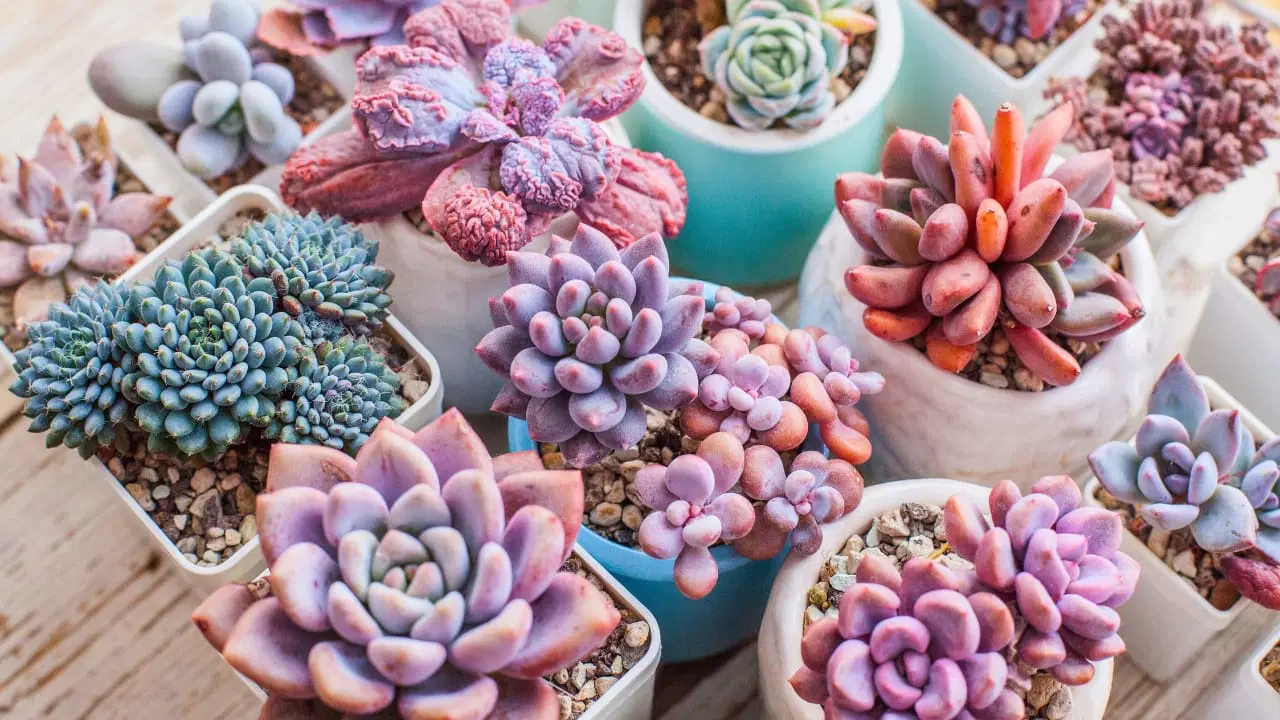Succulents have earned their place in our homes and gardens because of their resilience, charm, and variety. But one of their most fascinating features is often overlooked—many succulents change color when exposed to specific types of stress.
This isn’t a sign of damage, but rather a natural response that makes these plants even more stunning.
If you’ve ever spotted a red-tinted Echeveria or a jade plant with golden edges, you’ve seen this beautiful stress response in action.
In this guide, we’ll explore the types of succulents that change color with stress, what causes it, and how to safely encourage those vibrant hues without harming the plant.
Let’s dive into the world of color-changing succulents and how to care for them like a pro.
What Does “Stress” Mean for Succulents?
Stress might sound negative, but in the world of succulents, it’s often a trigger for beauty. Stress refers to environmental conditions that deviate from the plant’s ideal comfort zone. This includes:
- Intense sunlight
- Cooler night temperatures
- Less frequent watering
- Nutrient variation
- Tighter root space (crowded pots)
When exposed to these elements in moderation, many succulents produce anthocyanins and carotenoids—pigments that protect them and cause rich red, orange, pink, or purple tones.
Not all stress is good, though. Chronic overwatering, pest infestations, or disease can cause damage instead of vibrant color. The key lies in applying controlled stress.
Why Do Succulents Change Color?
Succulents change color as a defensive reaction. When exposed to high sunlight or temperature swings, their tissues produce pigments to protect against UV rays and water loss. This survival mechanism results in eye-catching hues.
Benefits of color change:
- Enhances aesthetic appeal
- Indicates healthy maturity in certain species
- Signals the need for care adjustments (too much sun, cold nights, etc.)
In some varieties, stress coloration is temporary and fades once the plant returns to a more stable environment. Others may maintain their hues longer if conditions remain slightly “challenging” but not harmful.
Types of Stress That Trigger Color Change
Succulents respond to certain stressors in fascinating ways—one of which is changing color. But not all stress is equal, and not all of it is beneficial. Below are the five primary types of stress that influence color change in succulents, along with tips to apply each method safely:
1. Sunlight Exposure
This is the most common and effective stressor used to bring out vibrant reds, purples, oranges, and even golds in succulents. When succulents receive increased light, especially direct sunlight, they begin producing protective pigments—such as anthocyanins and carotenoids—which act like natural sunscreens.
Tips:
- Gradually introduce your succulent to brighter light over several days to prevent sunburn.
- South- or west-facing windows are ideal for indoor plants.
- Outdoors, morning sun is gentler than harsh afternoon rays—consider partial shade during peak hours in hot climates.
Signs of healthy sun stress: Color intensifies, leaf edges or tips turn red, purple, or bronze.
Warning signs of too much sun: Bleached spots, dry patches, or scorched leaves. Move to filtered light immediately.
2. Temperature Fluctuations
Succulents are native to arid environments where day-to-night temperatures can vary significantly. Mild temperature swings—like warm days and cool nights—can trigger protective pigmentation.
Tips:
- Placing your succulents outdoors (seasonally) or near a window during cooler nights can mimic this effect.
- Avoid exposing succulents to frost or freezing temperatures, especially tropical species.
- Ideal night temps for mild stress: 10°C–15°C (50°F–59°F)
Temperature-induced stress often enhances deeper purples, burgundy, and copper tones, especially in Aeoniums and Echeverias.
3. Water Restriction (Drought Stress)
Watering less often forces the succulent to rely on stored moisture. This self-preservation response often leads to more vibrant coloring, especially in species like Sedums, Crassulas, and Graptopetalums.
Tips:
- Use the “soak and dry” method: water thoroughly, then allow soil to completely dry before watering again.
- In warm seasons, reduce watering to every 2–3 weeks depending on humidity and pot size.
- Avoid letting the plant wrinkle excessively—that indicates real thirst, not healthy stress.
4. Nutrient Control
High-nitrogen soil promotes fast, lush green growth—but at the cost of color. Reducing nitrogen levels and using a low-nitrogen succulent fertilizer supports slower, more compact growth and better pigment development.
Tips:
- Fertilize only during the active growing season (spring and summer).
- Opt for cactus/succulent blends with lower nitrogen and slightly higher phosphorus/potassium ratios.
- Too much fertilizer can make your plant green and leggy.
5. Pot Bound Roots and Limited Space
Some succulents react to crowded roots by intensifying pigmentation, especially when other stressors like light and water restriction are present.
Tips:
- Use smaller pots to gently restrict roots—but not to the point of stunted growth.
- Choose terracotta pots that wick away excess moisture and offer better airflow to roots.
- Watch for roots growing out of the drainage holes—a sign it might need repotting soon.
Important: Never stack stressors too quickly. Introduce one variable at a time and watch how your plant responds.
10 Stunning Succulents That Change Color with Stress
Now, let’s take a more detailed look at ten succulent varieties known for their dramatic transformations under the right conditions. Each has its own charm and color-shifting personality:
1. Echeveria ‘Perle von Nurnberg’
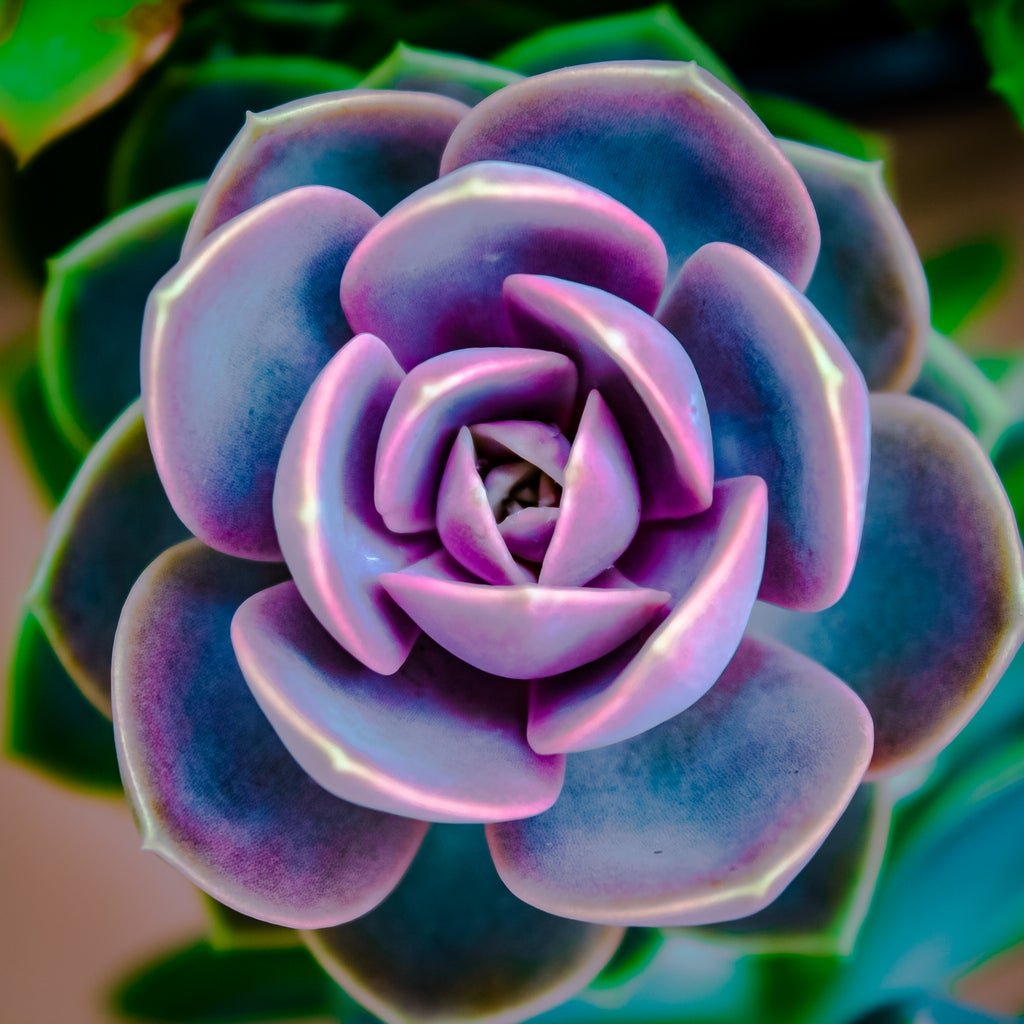
With its powdery lavender-gray rosettes, this popular hybrid becomes a showstopper when sun-stressed—shifting into glowing pinks and subtle magentas.
- Why it changes: High sun exposure and lower water prompt anthocyanin production.
- Best conditions: Bright indoor light or morning sun outdoors; well-draining cactus mix.
2. Sedum rubrotinctum (Jelly Bean Plant)

The plump, jelly-bean-shaped leaves of this quirky succulent start off lime green and blush into fiery red with sunlight and drier conditions.
- Why it changes: Carotenoids intensify as water levels drop.
- Pro tip: It’s prone to leaf drop if bumped—place it somewhere safe from foot traffic.
3. Crassula capitella ‘Campfire’
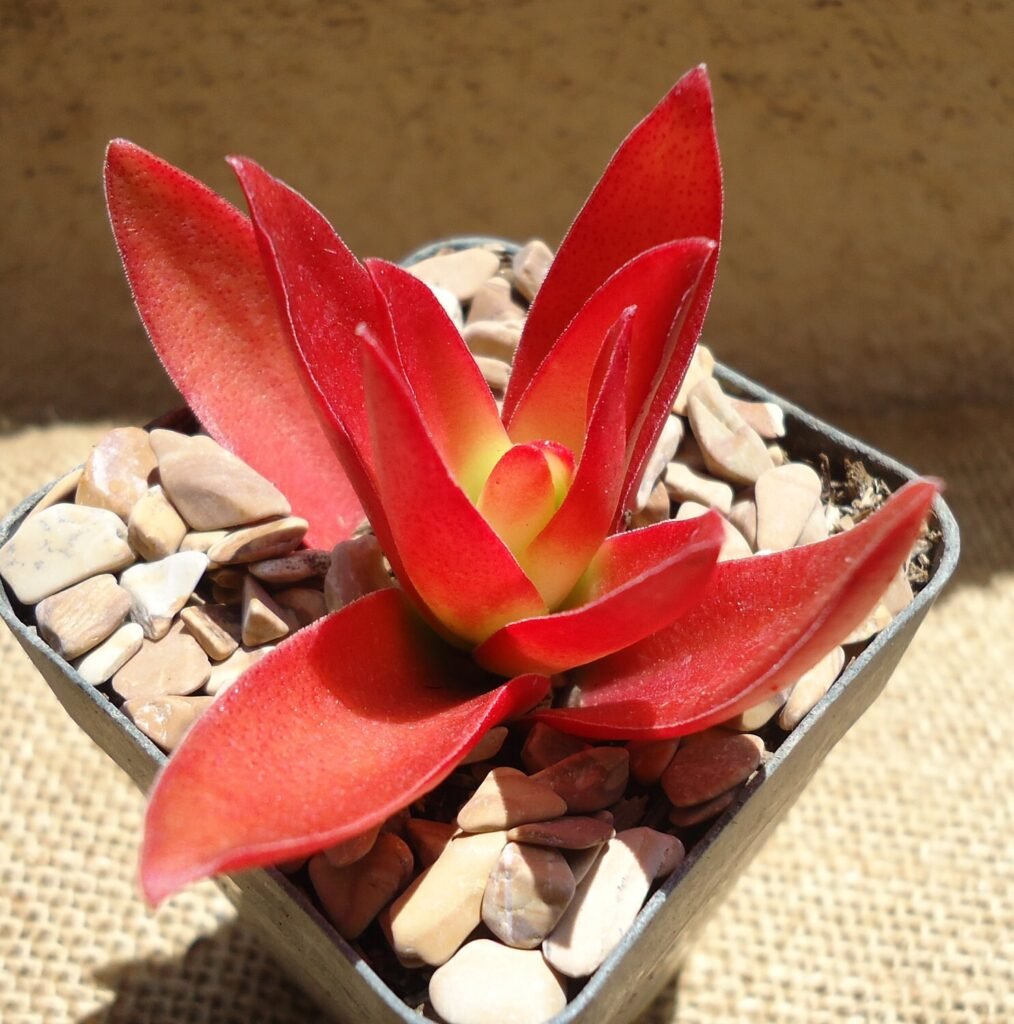
Shaped like stacked flames, its pointed leaves start green and transition to brilliant orange and red. This plant lights up a succulent arrangement instantly.
- Why it changes: Needs plenty of sun to fully develop its namesake color.
- Great for: Rock gardens, window boxes, or indoor sunny ledges.
4. Graptopetalum paraguayense (Ghost Plant)

Despite its spooky name, this beauty displays a watercolor-like transformation, with pale blue-grey tones shifting to dusty pinks and lavenders under mild stress.
- Why it changes: Sun and cool temps amplify its pastel hues.
- Fun fact: Extremely easy to propagate from dropped leaves.
5. Aeonium arboreum ‘Zwartkop’

One of the most dramatic succulents, the deep wine-colored rosettes look nearly black in strong sunlight. In lower light, they revert to green.
- Why it changes: Light intensity alters pigment density.
- Best placement: Outdoors in full sun, or indoors with supplemental grow lights.
6. Kalanchoe luciae (Flapjack or Paddle Plant)
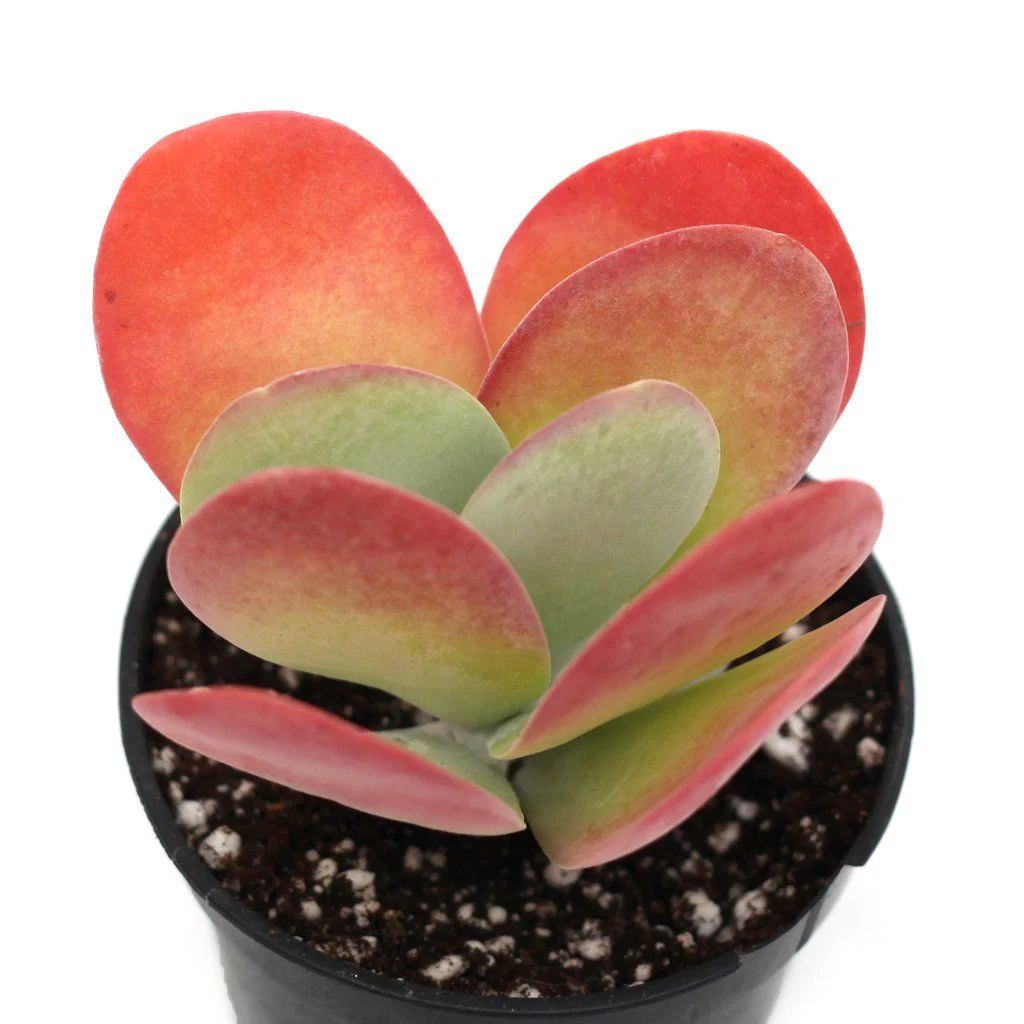
Large, paddle-shaped leaves flare outward like a bouquet and glow bright red at the edges when exposed to full sunlight.
- Why it changes: UV exposure triggers vivid red pigments at leaf margins.
- Note: Looks stunning in minimalist ceramic pots with white stones.
7. Aloe ‘Christmas Carol’
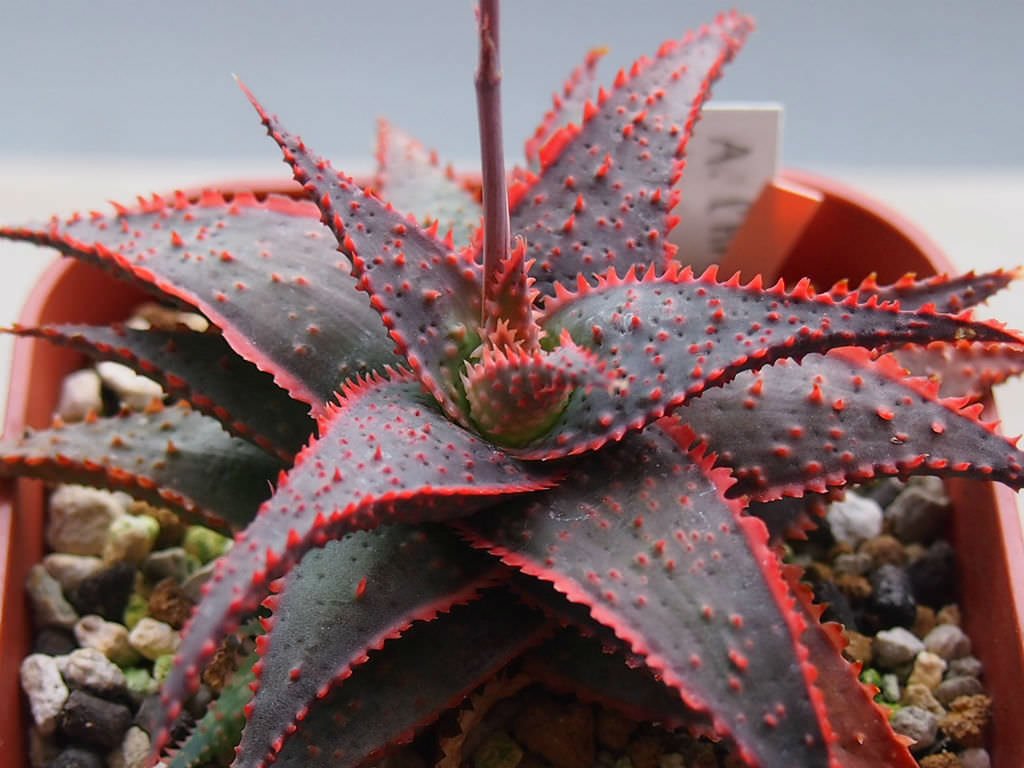
Unlike your typical green aloe, this hybrid develops deep red spots and borders as it grows in direct sunlight.
- Why it changes: UV stress and cooler temps deepen the contrast.
- Bonus: It also blooms with small coral-red flowers during winter!
8. Echeveria agavoides

The compact, agave-like form turns heads when the leaf tips shift into deep red, particularly in late summer.
- Why it changes: Sunlight and dry soil enhance the tip coloration.
- Maintenance: Clean dead leaves regularly to prevent pest buildup.
9. Graptosedum ‘California Sunset’
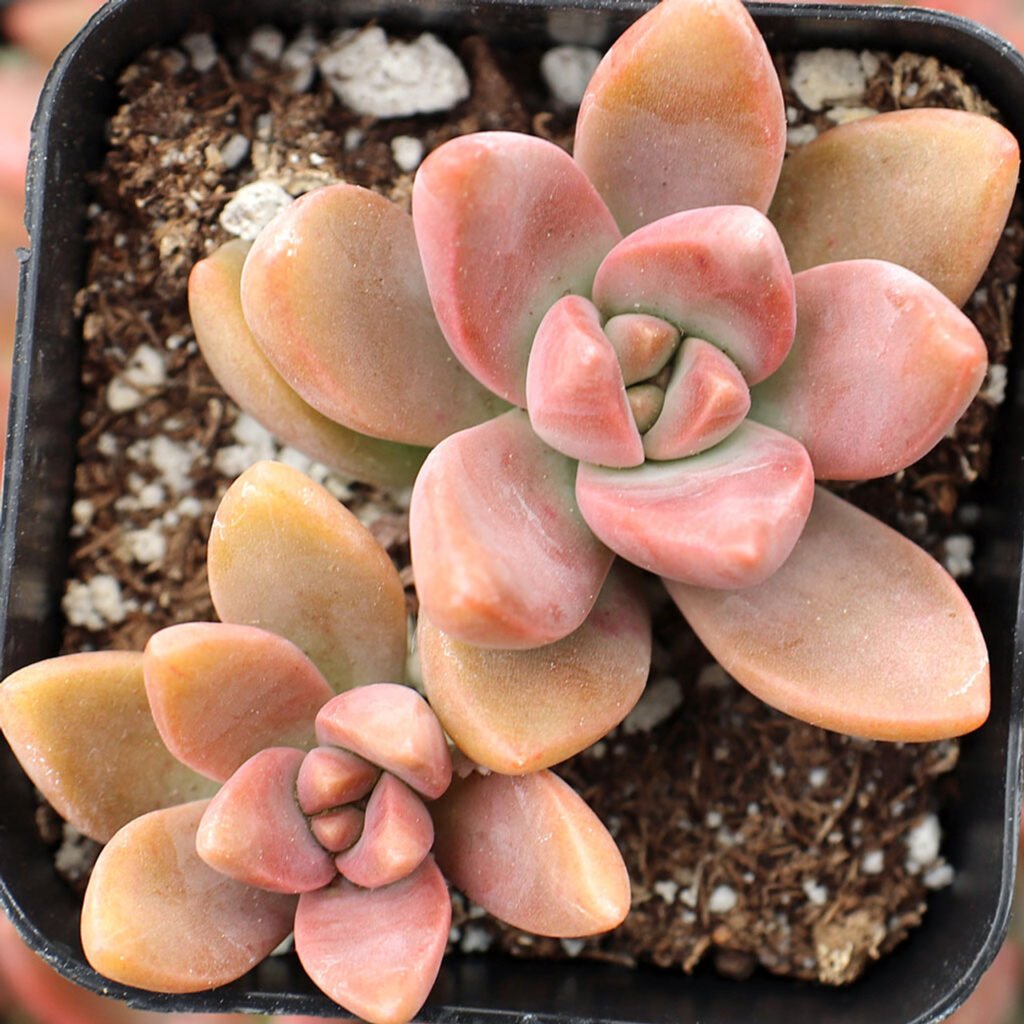
Blending the genetics of Graptopetalum and Sedum, this hybrid truly lives up to its name with peachy pink to coral tones in full sun.
- Why it changes: Sunlight and colder nights bring out its vivid warmth.
- Container tip: Works beautifully in hanging baskets or shallow dishes.
10. Crassula ovata ‘Hummel’s Sunset’
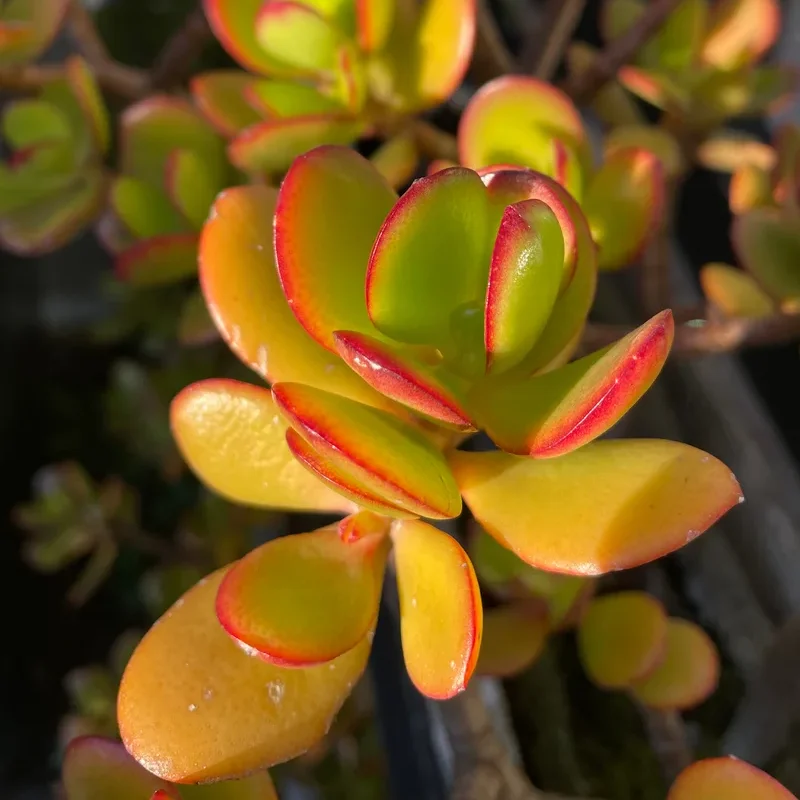
This vibrant jade plant features golden-green leaves with red-tinted edges, making it an ideal colorful accent.
- Why it changes: Full sun and slight drought stimulate the sunset tones.
- Best for: Bonsai-style shaping or tabletop displays.
Caring for Colorful Succulents Indoors
While stress-induced color changes are gorgeous, maintaining them indoors can be a bit more challenging. Here’s how to keep your vibrant succulents healthy and thriving inside your home.
Creating the Right Lighting Conditions
Lighting is key if you want colorful succulents indoors.
South-facing windows are ideal for natural sunlight. If your space lacks strong natural light, a full-spectrum LED grow light is a worthwhile investment. These lights replicate the spectrum of the sun and encourage pigmentation even in darker apartments.
Tips:
- Keep succulents 6–12 inches away from the grow light.
- Give them 10–14 hours of light daily if indoors full-time.
- Rotate your pots weekly to avoid lopsided growth.
Proper Watering for Healthy Stress
It’s a fine balance: enough water to stay alive, but not so much that they grow too quickly and lose color.
Let soil dry completely between waterings. Depending on your climate and the time of year, this might mean watering every 2–3 weeks.
Be sure to:
- Use pots with drainage holes.
- Stick with the soak-and-dry method.
- Avoid water sitting on rosettes, especially in humid environments.
Potting and Soil That Support Color
Poor drainage leads to root rot, dull growth, and bland color.
Use a succulent or cactus-specific mix, or make your own using:
- 2 parts potting soil
- 1 part coarse sand or perlite
- Optional: a small amount of crushed lava rock for minerals
Choose terra cotta pots for better airflow and water evaporation, which contributes to healthy stress levels.
Propagation Tips for Colorful Succulents
Many of the succulents mentioned can be easily propagated, which means you can multiply your colorful collection for free.
Propagation Methods

- Leaf Propagation (great for Graptopetalum, Echeveria):
Gently twist off a plump, healthy leaf. Let it dry for 2–4 days, then place it on top of dry soil. Mist lightly every few days until roots and new rosettes form. - Stem Cuttings (ideal for Sedum, Crassula):
Use clean shears to snip a few inches of stem. Let it callus, then plant in dry soil. Water only after roots appear. - Offsets/Pups (used for Aloe, Kalanchoe):
Gently remove baby plants from the base and pot separately.
Remember: Color intensity in new plants may take time and proper stress to develop. Keep them in strong light and be patient.
Designing with Color-Changing Succulents
Succulents that blush or shift colors are not only botanical wonders—they’re also incredible design elements.
Styling Ideas for Home and Garden
- Statement Planters: Use white or black containers to highlight the vibrant tones.
- Layered Arrangements: Pair green succulents with red or purple ones for striking contrast.
- Table Centerpieces: Combine small color-shifting varieties in low trays with decorative stones.
- Vertical Gardens: Use wall frames or hanging pockets for a living color wall.
You can even create seasonal arrangements, as many succulents change color more dramatically in winter or during drought periods.
Common Problems and How to Fix Them
Colorful succulents may look tough, but like all plants, they need the right care to thrive. Here’s how to troubleshoot common issues.
Fading or Dull Color
This is usually caused by insufficient light. Move your plant closer to a light source or increase artificial light.
Leggy or Stretched Growth (Etiolation)
When succulents stretch and lose their compact form, it means they’re reaching for more light. Again, this is a sign of poor light conditions. Trim the top rosette and replant it if needed.
Scorched Leaves
Too much direct sun—especially in hot climates—can cause burns. Look for brown or bleached patches. Gradually adjust your plant to outdoor light or use shade cloth during peak sun hours.
Root Rot
This usually happens from overwatering or poor drainage. If the base feels mushy or dark, remove the affected parts, let the healthy section callus, and replant in fresh soil.
Are These Succulents Safe Around Pets or Kids?
Many succulents are non-toxic, but not all. Some color-changing varieties like Echeveria and Graptopetalum are pet-safe, while others like Kalanchoe or Aloe can be toxic if ingested.
Tips:
- Check the ASPCA plant toxicity list before purchasing.
- Place succulents out of reach if you have curious pets or toddlers.
- Teach children that these plants are not toys or snacks.
When to Expect the Most Color
Color is most vibrant during:
- Summer and fall, when sunlight is strong
- Cooler nights, especially for outdoor succulents
- After drought periods (carefully controlled water stress)
- Post-propagation, once the plant settles in and is slightly stressed
For indoor plants, you can mimic this by adjusting lighting and watering slightly during the year.
FAQs: Succulents That Change Color with Stress
1. Is color change permanent in succulents?
No. The color often fades if the stressor is removed (e.g., if light decreases or watering increases). The plant returns to a greener tone as it relaxes.
2. Can all succulents change color?
Not all. Only specific species—especially those that naturally produce pigments—will show noticeable changes.
3. Will stressing my succulent harm it?
Not if done correctly. Mild, controlled stress (like sun and drought) is safe. Extreme stress, however, can lead to damage or death. Watch your plant’s reactions.
4. Why is my succulent not changing color?
It might be:
- Too young
- Not receiving enough light
- Getting too much water or fertilizer
- The wrong species for color change
Give it time, and adjust conditions gradually.
Final Thoughts: Embrace the Colorful Side of Succulents
Succulents that change color with stress are living proof that plants can be expressive, resilient, and downright stunning. Whether you’re a seasoned plant lover or just getting started, adding these transformative beauties to your collection brings not just style—but also the joy of seeing your plant respond to the care you give it.
With the right mix of light, drought, and gentle stress, you’ll discover a rainbow of reds, purples, pinks, oranges, and golds emerging from your succulents—all within your home or garden.
So experiment thoughtfully, pay attention to your plant’s needs, and enjoy the magic of watching your greenery blush with beauty.
